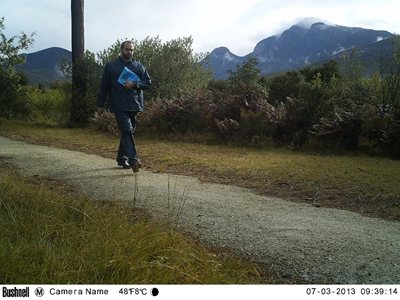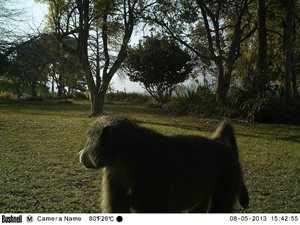 Current management policy, although required to be ‘scientifically’ based, largely relies on studies done outside the Garden Route. My study addresses how the management of human-baboon relations could be improved on the campus.
Current management policy, although required to be ‘scientifically’ based, largely relies on studies done outside the Garden Route. My study addresses how the management of human-baboon relations could be improved on the campus.
I undertook a case study which aimed at addressing the cohabitation of baboons and humans on the Nelson Mandela University campus, specifically human-baboon resource selection and interaction.
The research methodology and the related analytical tools were primarily quantitative but were supplemented by some qualitative data drawn from interviews. I did a desktop study of service delivery, and camera trap and road surveys of baboon occupancy to determine landscape features acting as Keystone Resource Areas (KRAs) for both humans and baboons on the campus.
I also did a household questionnaire survey, and combined it with road surveys and the desktop study to determine relationships between the frequency and location of negative interactions, and resident-baboon distribution on the campus.
Two main findings were made. First, residences, non-residence buildings and waste disposal stations act as KRAs for both humans and baboons. Second, the frequency of negative interaction correlates with the time spent by residents and baboons at residences, where common negative interactions between baboons and humans are known to occur.
I postulate from my findings that cohabitation on the Nelson Mandela University George Campus is causing the  habituation of baboons, a loss of fear of humans and association of humans with high energy foods. Present cohabitation, as a result, contributes to negative human-baboon relations in the George area. I recommend implementing zonation and wildlife monitoring to reverse the loss of baboon fear of humans and better limit the availability of human-derived foods, to ensure peaceful co-existence between humans and baboons on the George Campus. Management should also consider giving stakeholders co-management roles to foster and facilitate knowledge and responsibility partnerships, and subsequently correct any misunderstandings related to human-baboon relations on the campus.
habituation of baboons, a loss of fear of humans and association of humans with high energy foods. Present cohabitation, as a result, contributes to negative human-baboon relations in the George area. I recommend implementing zonation and wildlife monitoring to reverse the loss of baboon fear of humans and better limit the availability of human-derived foods, to ensure peaceful co-existence between humans and baboons on the George Campus. Management should also consider giving stakeholders co-management roles to foster and facilitate knowledge and responsibility partnerships, and subsequently correct any misunderstandings related to human-baboon relations on the campus.
What the SRU meant to me
The SRU is where I took my first, albeit (sometimes) clumsy, steps as a researcher. I had unforgettable experiences, learned important lessons and got to know wonderful people. I will always treasure what I take with me from my time here, wherever I go.
Highlights of my journey
Walking 2 304km in road surveys, meeting so many people who each have their own story regarding baboons in the George Area, and seeing a caracal on 2 different occasions, the antics of baboon youngsters and the care of a baboon mother for her new born.